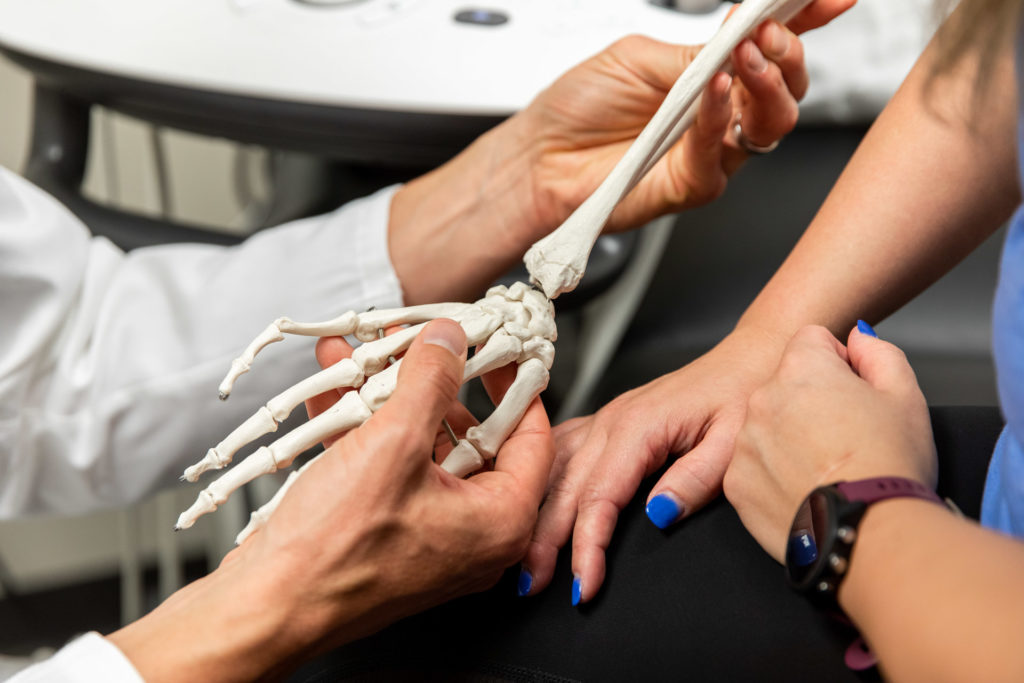
What is the carpal tunnel?
The carpal tunnel is a passageway in the wrist formed by the eight carpal (wrist) bones, which make up the floor and sides of the tunnel, and the transverse carpal ligament, a strong ligament stretching across the roof of the tunnel. Residing inside the carpal tunnel are the nine tendons that bend your fingers and thumb toward the palm.
Also running through the carpal tunnel is the median nerve, a structure about the size of a pencil, containing thousands of nerve fibers. These supply the sensation to your thumb, index finger, long finger and the thumb half of the ring finger, as well as control the three small muscles at the base of the thumb. The median nerve lies directly beneath the transverse carpal ligament and comes in contact with the ligament when we flex or extend the wrist.
What is carpal tunnel syndrome?
Carpal tunnel syndrome is a clinical condition caused by increased pressure in the carpal tunnel, resulting in compression of the median nerve. Thickening of the lining of the tendons or of the transverse carpal ligament can restrict the space within the tunnel, causing the nerve to become pressed against the ligament forming the roof of the tunnel.
When the relatively soft structure of the median nerve is pushed up against the ligament, blood flow to the nerve is restricted, causing a sensation often described as “pins and needles” to the fingers. If left untreated, the symptoms may progress to the point of constant numbness, which may cause permanent damage to the nerve.
What causes carpal tunnel syndrome?
The true cause of the majority of cases of carpal tunnel syndrome is unknown and is termed “idiopathic.” Recent research has shown that the two factors most commonly associated with the development of carpal tunnel syndrome are advancing age and genetics (female gender and positive family history). Research also has indicated that using a keyboard does not appear to be related to this condition, despite the wide assumption otherwise. In addition, certain medical conditions can predispose to the presentation of carpal tunnel syndrome symptoms:
- Inflammation, swelling or thickening about the flexor tendons
- Systemic inflammatory disease such as rheumatoid arthritis
- Hypothyroidism
- Trauma
- Fractures and dislocations around the wrist
- Crushing injuries
- Pregnancy
- Diabetes
What are the symptoms of carpal tunnel syndrome?
The most common symptoms are numbness and tingling of one or more of the fingers. The numbness generally does not affect the small finger, as the sensation in that area is served by a different nerve, although it is sometimes difficult to distinguish this when the numbness is severe. Associated symptoms, including burning pain or radiation of pain up the arm, can also be present.
Episodes of numbness can occur with activities such as driving, holding a book while reading, or talking on the phone, but it also frequently occurs at night while sleeping. This is due to the fact that the wrists tend to rest in a flexed posture, thereby increasing the pressure on the median nerve. Patients may actually be awakened by the numbness or may notice numbness in the hands when they wake up in the morning.
Relief of symptoms can sometimes be achieved by shaking the hands or putting the hands over the side of the bed. Decreased sensation in the fingers may result in clumsiness and weakness of the affected hand. Patients may find themselves dropping objects and may be less capable of performing tasks requiring sustained gripping or pinching strength. With advanced carpal tunnel syndrome, a patient may develop numbness that is constant or the muscles at the base of the thumb may begin to waste away, giving a flattened appearance to the palm.


